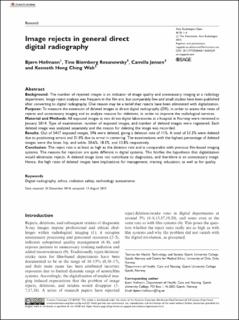| dc.description.abstract | Background: The number of rejected images is an indicator of image quality and unnecessary imaging at a radiology department. Image reject analysis was frequent in the film era, but comparably few and small studies have been published after converting to digital radiography. One reason may be a belief that rejects have been eliminated with digitalization. Purpose: To measure the extension of deleted images in direct digital radiography (DR), in order to assess the rates of rejects and unnecessary imaging and to analyze reasons for deletions, in order to improve the radiological services. Material and Methods: All exposed images at two direct digital laboratories at a hospital in Norway were reviewed in January 2014. Type of examination, number of exposed images, and number of deleted images were registered. Each deleted image was analyzed separately and the reason for deleting the image was recorded. Results: Out of 5417 exposed images, 596 were deleted, giving a deletion rate of 11%. A total of 51.3% were deleted due to positioning errors and 31.0% due to error in centering. The examinations with the highest percentage of deleted images were the knee, hip, and ankle, 20.6%, 18.5%, and 13.8% respectively. Conclusion: The reject rate is at least as high as the deletion rate and is comparable with previous film-based imaging systems. The reasons for rejection are quite different in digital systems. This falsifies the hypothesis that digitalization would eliminates rejects. A deleted image does not contribute to diagnostics, and therefore is an unnecessary image. Hence, the high rates of deleted images have implications for management, training, education, as well as for quality. | en_US |

